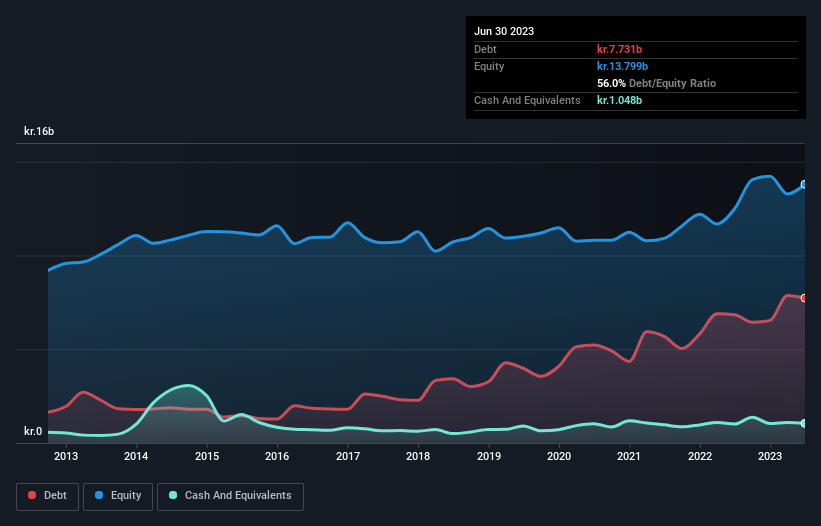These 4 Measures Indicate That Novozymes (CPH:NZYM B) Is Using Debt Reasonably Well
The external fund manager backed by Berkshire Hathaway's Charlie Munger, Li Lu, makes no bones about it when he says 'The biggest investment risk is not the volatility of prices, but whether you will suffer a permanent loss of capital.' So it seems the smart money knows that debt - which is usually involved in bankruptcies - is a very important factor, when you assess how risky a company is. We note that Novozymes A/S (CPH:NZYM B) does have debt on its balance sheet. But is this debt a concern to shareholders?
When Is Debt Dangerous?
Debt assists a business until the business has trouble paying it off, either with new capital or with free cash flow. If things get really bad, the lenders can take control of the business. However, a more frequent (but still costly) occurrence is where a company must issue shares at bargain-basement prices, permanently diluting shareholders, just to shore up its balance sheet. Of course, the upside of debt is that it often represents cheap capital, especially when it replaces dilution in a company with the ability to reinvest at high rates of return. The first thing to do when considering how much debt a business uses is to look at its cash and debt together.
Check out our latest analysis for Novozymes
What Is Novozymes's Net Debt?
The image below, which you can click on for greater detail, shows that at June 2023 Novozymes had debt of kr.7.73b, up from kr.6.84b in one year. However, it also had kr.1.05b in cash, and so its net debt is kr.6.68b.

How Strong Is Novozymes' Balance Sheet?
Zooming in on the latest balance sheet data, we can see that Novozymes had liabilities of kr.6.84b due within 12 months and liabilities of kr.7.59b due beyond that. Offsetting this, it had kr.1.05b in cash and kr.4.30b in receivables that were due within 12 months. So it has liabilities totalling kr.9.08b more than its cash and near-term receivables, combined.
Given Novozymes has a humongous market capitalization of kr.80.0b, it's hard to believe these liabilities pose much threat. But there are sufficient liabilities that we would certainly recommend shareholders continue to monitor the balance sheet, going forward.
In order to size up a company's debt relative to its earnings, we calculate its net debt divided by its earnings before interest, tax, depreciation, and amortization (EBITDA) and its earnings before interest and tax (EBIT) divided by its interest expense (its interest cover). This way, we consider both the absolute quantum of the debt, as well as the interest rates paid on it.
Novozymes has a low net debt to EBITDA ratio of only 1.2. And its EBIT easily covers its interest expense, being 35.0 times the size. So you could argue it is no more threatened by its debt than an elephant is by a mouse. Fortunately, Novozymes grew its EBIT by 8.7% in the last year, making that debt load look even more manageable. When analysing debt levels, the balance sheet is the obvious place to start. But ultimately the future profitability of the business will decide if Novozymes can strengthen its balance sheet over time. So if you want to see what the professionals think, you might find this free report on analyst profit forecasts to be interesting.
Finally, a business needs free cash flow to pay off debt; accounting profits just don't cut it. So the logical step is to look at the proportion of that EBIT that is matched by actual free cash flow. In the last three years, Novozymes's free cash flow amounted to 47% of its EBIT, less than we'd expect. That weak cash conversion makes it more difficult to handle indebtedness.
Our View
Happily, Novozymes's impressive interest cover implies it has the upper hand on its debt. And its net debt to EBITDA is good too. Looking at all the aforementioned factors together, it strikes us that Novozymes can handle its debt fairly comfortably. Of course, while this leverage can enhance returns on equity, it does bring more risk, so it's worth keeping an eye on this one. When analysing debt levels, the balance sheet is the obvious place to start. However, not all investment risk resides within the balance sheet - far from it. Case in point: We've spotted 2 warning signs for Novozymes you should be aware of.
Of course, if you're the type of investor who prefers buying stocks without the burden of debt, then don't hesitate to discover our exclusive list of net cash growth stocks, today.
Valuation is complex, but we're here to simplify it.
Discover if Novozymes might be undervalued or overvalued with our detailed analysis, featuring fair value estimates, potential risks, dividends, insider trades, and its financial condition.
Access Free AnalysisHave feedback on this article? Concerned about the content? Get in touch with us directly. Alternatively, email editorial-team (at) simplywallst.com.
This article by Simply Wall St is general in nature. We provide commentary based on historical data and analyst forecasts only using an unbiased methodology and our articles are not intended to be financial advice. It does not constitute a recommendation to buy or sell any stock, and does not take account of your objectives, or your financial situation. We aim to bring you long-term focused analysis driven by fundamental data. Note that our analysis may not factor in the latest price-sensitive company announcements or qualitative material. Simply Wall St has no position in any stocks mentioned.
About CPSE:NSIS B
Novozymes
Produces and sells industrial enzymes, functional proteins, and microorganisms in Denmark, rest of Europe, North America, the Asia Pacific, the Middle East, Africa, Latin America, and internationally.
Excellent balance sheet average dividend payer.
Similar Companies
Market Insights
Community Narratives



